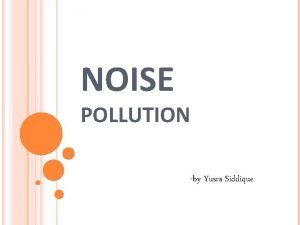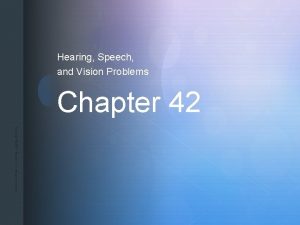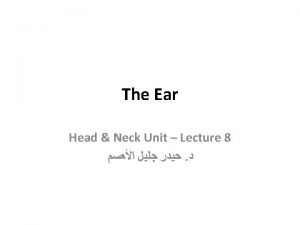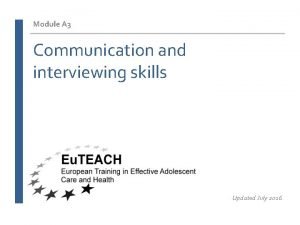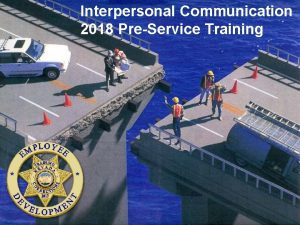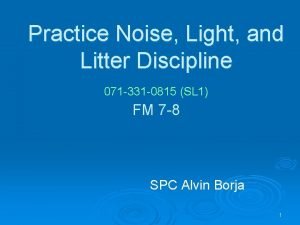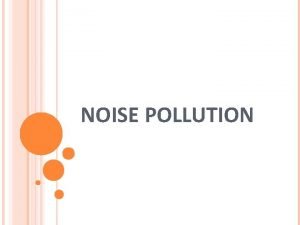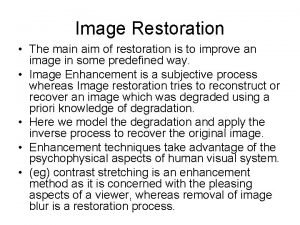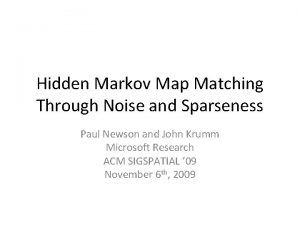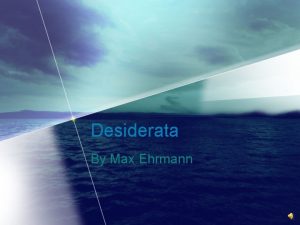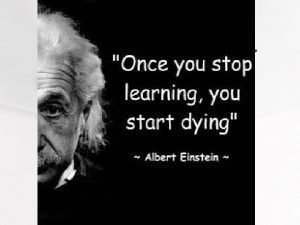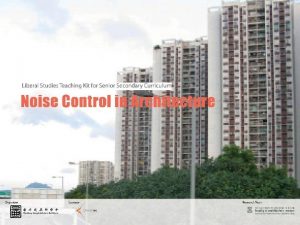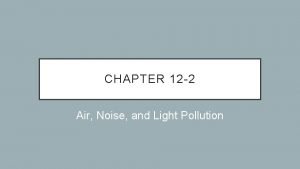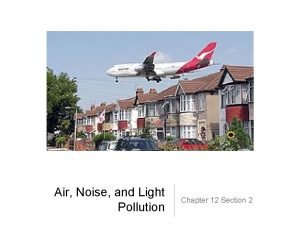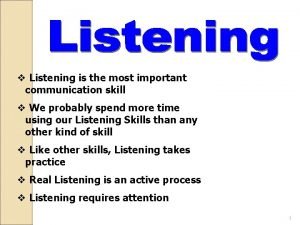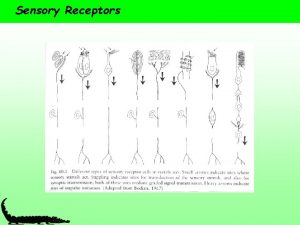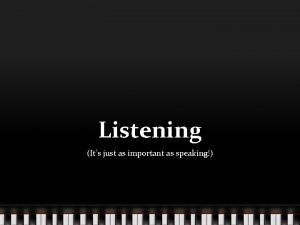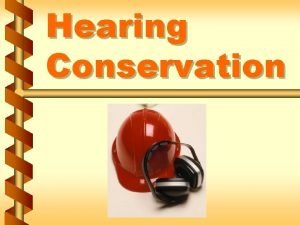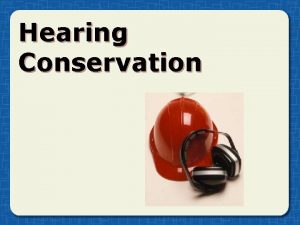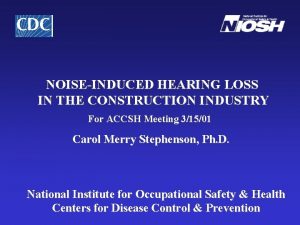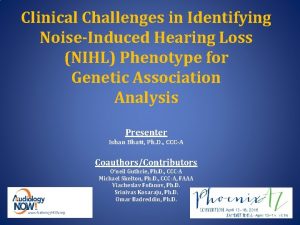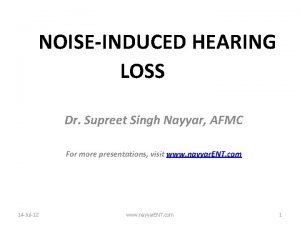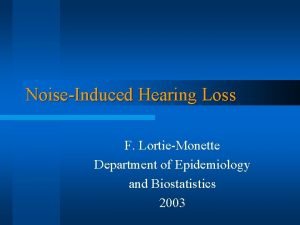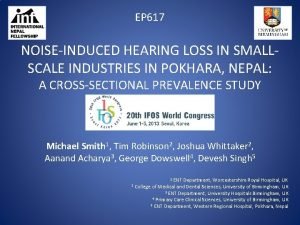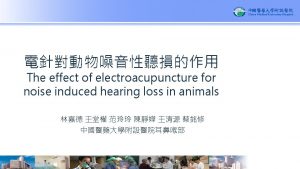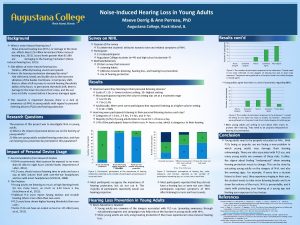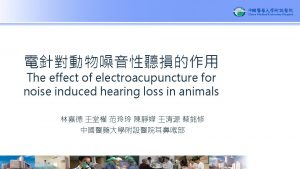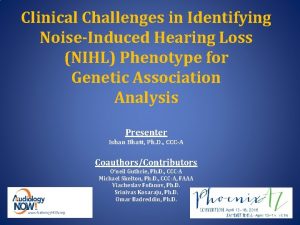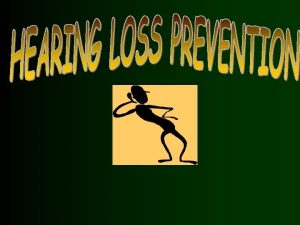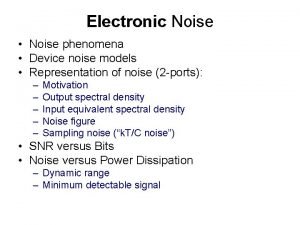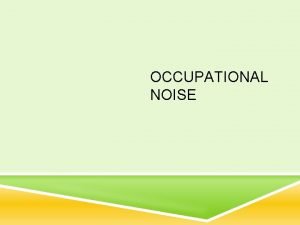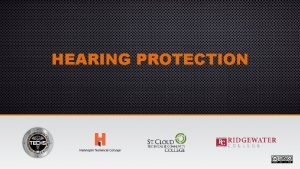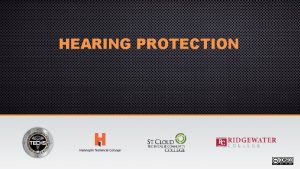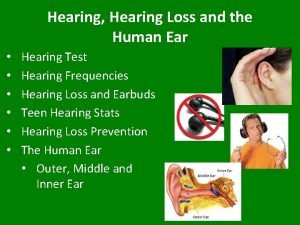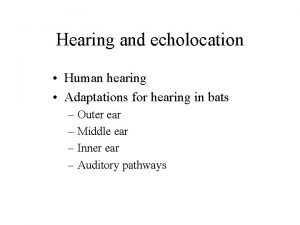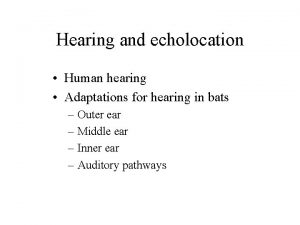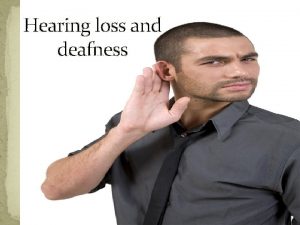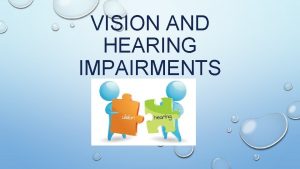Effects of noise on hearing and Noiseinduced hearing



























- Slides: 27

Effects of noise on hearing and “Noise-induced hearing loss” Peter R Thorne Section of Audiology, Department of Physiology and Centre for Brain Research

Introduction Purpose: • to look at what we know about the incidence and prevalence of “Noise-induced Hearing Loss” in NZ • what factors influence hearing loss from noise

Noise and Hearing • Noise exposure causes injury to the inner ear and temporary and permanent hearing loss: clinically latter is NIHL or Noise-induced hearing loss • Has always been assumed that Temporary effects are precursors to Permanent damage. This is being challenged, including our own research, suggesting some temporary loss is the ear adapting to noise.

Noise and Hearing • Main factor defining severity and rate of progression of injury and loss of hearing is the sound energy; defined by the intensity (loudness) and duration of the sound exposure.

New Zealand Exposure Limits to produce permanent loss (and other jurisdictions too) Time-Weighted Average =100% Dose Recommended exposure limit 85 d. BA 8 hours 88 d. BA 4 hours 91 d. BA 2 hours 94 d. BA 1 hour 97 d. BA 30 minutes 100 d. BA 15 minutes 103 d. BA 7. 5 minutes 106 d. BA 3. 25 minutes …. . 3 d. B exchange rate

What do these levels mean?

The audiogram is key quantitative index of the noise injury with greater loss at 4 k. Hz. Extent of loss correlated to intensity and duration deepens Study of weaving factory workers, (Burns 1963) broadens Noise-induced Hearing Loss 7

Influence of Duration and Intensity For given intensity hearing loss plateau after ~10 yrs exposure 8

Increasing evidence that TTS is not totally reversible. TTS in young mice (16 wks) recovers but suprathreshold changes in ABR suggest neural injury. Cochlea show loss of synapses and nerve fibres (Kujawa and Liberman, J Neurosci , 29: 14077– 14085 , 2009)

• These data suggest that some injury with TTS may not recover although thresholds do • Indicate that noise injury has profound suprathreshold functional changes • Indicates that thresholds (audiogram) may not be sensitive index of noise-induced functional change

Noise a predominant occupational hazard • Noisy industries major cause of hearing loss

Noise levels in NZ Industries Note the large range of exposure levels 12

1. Estimates of Incidence and Prevalence of NIHL • International estimates are 10 -30% of hearing loss prevalence is due to noise exposure • WHO data suggest 16% of hearing loss is due to noise • No previous epidemiological data for NZ. NIHL epidemiology difficult to do.

Modelling Estimates of Prevalence and Incidence • Using Global Burden of Disease model for occupational NIHL (WHO, Concha-Barrientos et al. , 2004) • Proportion of working population in economic sectors exposed to noise (>85 d. BA) estimated from international and NZ data; • Relative risk of occupational noise-induced hearing loss above background (age) estimated from ISO 1999 -1990; • NZ data obtained from field measurements of noise levels in different industries and personal dosimetry • International data obtained from NIOSH (1998), WHO (2004) and Prince et al. , (1997)

Modelling Estimates of Prevalence and Incidence • Modelled prevalence and incidence calculated (DISMOD II software) using NZ hearing loss prevalence data (eg Greville, 2005) and census data (NZ Statistics retrospective and prospective estimates); • Estimated for 2006 as anchor year (last census) and backward and forward (1986 -2030) • Using international data and NZ data provides a range of estimates • Important that these are seen as estimates only

Estimated number of new cases of NIHL (>25 d. BHL 0. 5 -4 k. Hz) in the workforce has increased since 1986, but incidence (rate) has decreased.

Estimated number of new cases of NIHL (>25 d. BHL 0. 5 -4 k. Hz) in the workforce has increased since 1986, but incidence (rate) has decreased. This we assume to be due to decline in workforce in noisy industries

Comparison of prevalence estimates with International (WHO) and NZ data Measure WHO Data N % NZ Data Prevalence Hearing Impaired Population N % % NIHL only, Workforce 29242 1. 47 42497 2. 14 Some NIHL Workforce 42309 2. 13 47026 2. 37 NIHL only, Population 62169 1. 54 69613 1. 73 15. 4 -17. 3 Some NIHL Population 90699 2. 25 104088 2. 58 22. 5 -25. 8 *Assuming a prevalence of hearing loss in NZ of 10% (Greville, 2005)

Comparison of prevalence estimates with International (WHO) and NZ data Measure WHO Data N % NZ Data Prevalence Hearing Impaired Population N % % NIHL only, Workforce 29242 1. 47 42497 2. 14 Some NIHL Workforce 42309 2. 13 47026 2. 37 NIHL only, Population 62169 1. 54 69613 1. 73 15. 4 -17. 3 Some NIHL Population 90699 2. 25 104088 2. 58 22. 5 -25. 8 *Assuming a prevalence of hearing loss in NZ of 10% (Greville, 2005)

Comparison of prevalence estimates with International (WHO) and NZ data Measure WHO Data N % NZ Data Prevalence Hearing Impaired Population N % % NIHL only, Workforce 29242 1. 47 42497 2. 14 Some NIHL Workforce 42309 2. 13 47026 2. 37 NIHL only, Population 62169 1. 54 69613 1. 73 15. 4 -17. 3 Some NIHL Population 90699 2. 25 104088 2. 58 22. 5 -25. 8 *Assuming a prevalence of hearing loss in NZ of 10% (Greville, 2005)

Comparison of prevalence estimates with International (WHO) and NZ data Measure WHO Data N % NZ Data Prevalence Hearing Impaired Population N % % NIHL only, Workforce 29242 1. 47 42497 2. 14 Some NIHL Workforce 42309 2. 13 47026 2. 37 NIHL only, Population 62169 1. 54 69613 1. 73 15. 4 -17. 3 Some NIHL Population 90699 2. 25 104088 2. 58 22. 5 -25. 8 *Assuming a prevalence of hearing loss in NZ of 10% (Greville, 2005)

Estimates of prevalence of NIHL by occupation/industry Total Number of NIHL Cases by Industry (Male 25 db. HL+) Services 4% Finance 2% Trans 4% Education 1% NEI 3% Ag 11% Mining 3% Trade 7% Mfg 29% Constr 36% Elec 0%

Estimates show similarity to level of hearing loss in different industries

2. Variation in Individual Susceptibility to Noise • Very clear that individuals show different sensitivities to the same noise exposure, indicating that there are other factors which define the response to noise.

Factors Affecting Risk of NIHL Genetic differences (Gates et al. , 2000, Rosenhall et al. , 2003) Solvents and ototoxic drugs/compounds, smoking (eg. Uchida et al. , 2005; Wild et al. , 2005) Sex/gender Age? Exposure variances = Large variation in susceptibility

Factors Affecting Risk of NIHL in Humans Frequency (Hz) 250 500 1000 2000 4000 6000 8000 -10 Hearing Level (d. BHL) 0 10 20 30 40 50 Normal 10 percentile 50 percentile 90 percentile 60 70 80 90 65 year old males exposed > 10 years ISO 1999 -1990 10 yr exposure at 100 d. BLAeq

Conclusions and Implications • Prevalence of occupational NIHL in NZ is around 1. 52. 4% of workforce and 1. 5 -2. 6% of the population (1525% of the hearing impaired population) • Estimate around 1800 new cases each year • Effects of noise on the ear affected by many factors. Genetic and environmental influences significant • Thresholds (Audiogram) may be insensitive to injury and do not tell the full story
 Quantizing noise (quantization noise):
Quantizing noise (quantization noise): How to avoid noise pollution
How to avoid noise pollution Chapter 42 hearing speech and vision problems
Chapter 42 hearing speech and vision problems The receptors for hearing are the
The receptors for hearing are the Bony labrynth
Bony labrynth Sight hearing taste smell and touch
Sight hearing taste smell and touch Barriers to listening
Barriers to listening Proxemics in communication skills
Proxemics in communication skills Hku speech and hearing
Hku speech and hearing What is light discipline
What is light discipline Source of noise pollution
Source of noise pollution Enlighten about image noise and restoration
Enlighten about image noise and restoration Hidden markov map matching through noise and sparseness
Hidden markov map matching through noise and sparseness Desiderata by max ehrmann
Desiderata by max ehrmann External internal semantic noise
External internal semantic noise Fork is countable or uncountable
Fork is countable or uncountable Noise and sound difference
Noise and sound difference Superlative and comparative of noisy
Superlative and comparative of noisy Ripple noise定義
Ripple noise定義 Air noise and light pollution
Air noise and light pollution Section 2 air noise and light pollution
Section 2 air noise and light pollution Pseudo listening definition
Pseudo listening definition Listening vs hearing
Listening vs hearing Active listening vs hearing
Active listening vs hearing Vertebrate sensory receptors
Vertebrate sensory receptors What caused lady montague's death
What caused lady montague's death Hearing on advisement
Hearing on advisement Listening vs hearing
Listening vs hearing

